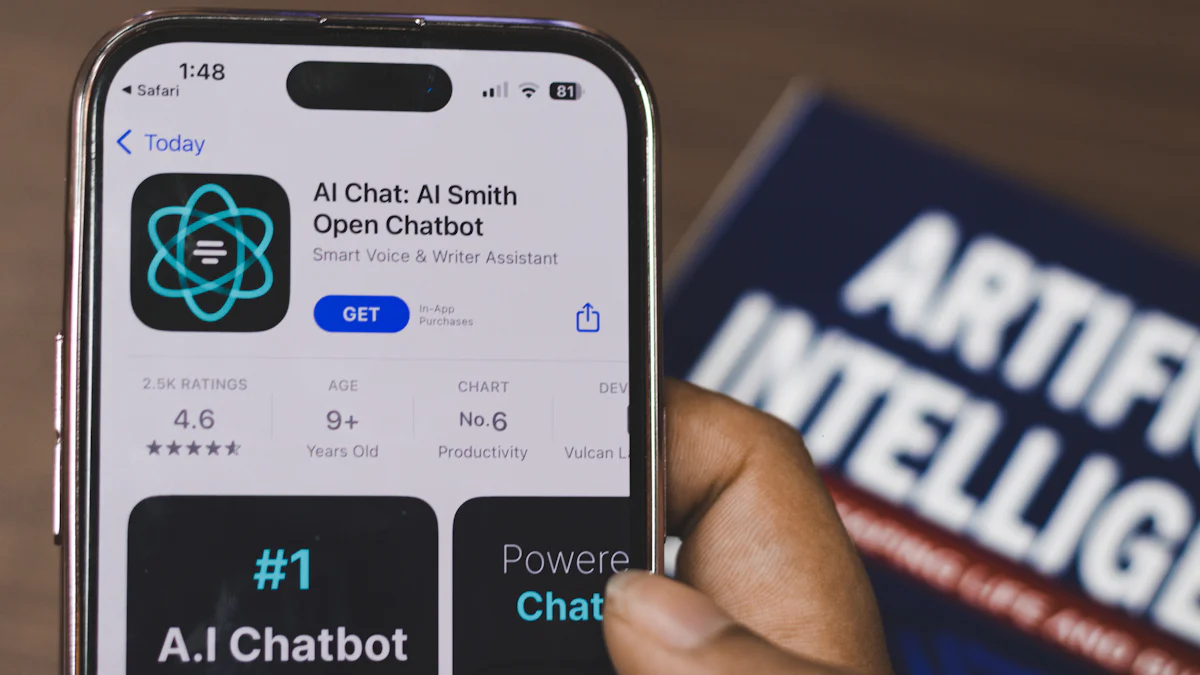Building a Voice Generation Model with AI

Artificial Intelligence (AI) has revolutionized voice technology, transforming how we interact with machines. I have seen AI's impact firsthand, especially in creating realistic voice generation models. These models play a crucial role in modern applications, from virtual assistants to accessibility tools. AI voice technology offers cost-effective and scalable solutions across industries. McKinsey estimates that generative AI, including voice technologies, could add up to $4.4 trillion in economic value. Today, advanced AI makes voice cloning easier, enhancing the capabilities of voice generation models.
Understanding Voice Generation Models
Definition and Key Concepts
What is a Voice Generation Model?
A Voice Generation Model is a sophisticated system that creates human-like speech from text. I find it fascinating how these models can mimic the nuances of human speech. They analyze text input and convert it into audio output, making them essential in applications like virtual assistants and audiobooks. The model's ability to produce natural-sounding speech depends on its design and the quality of data it uses.
How AI Powers Voice Generation
AI plays a crucial role in powering voice generation. It uses deep learning algorithms to understand and replicate human speech patterns. I have seen how AI can analyze vast amounts of voice data to learn different accents, tones, and speech styles. This capability allows the model to generate speech that sounds remarkably human. AI's adaptability makes it possible to improve voice generation models continuously, enhancing their accuracy and naturalness.
Historical Context
Evolution of Voice Technology
Voice technology has come a long way since its inception. The creation of the first computer-based speech synthesis systems in the late 1950s marked the beginning of a new era. Machines could now generate, manipulate, and replicate human speech. This breakthrough laid the foundation for future advancements in voice technology.
Milestones in AI Voice Generation
Several milestones have shaped the development of AI voice generation. In the 1980s, Bell Labs introduced a Multilingual Text-to-Speech System. This innovation paved the way for modern AI voice generators. Another significant advancement was the DECtalk system, which used the formant synthesis method. This method closely emulated human voice characteristics, representing a leap forward in machine-generated speech. These milestones highlight the rapid progress in voice generation technology, driven by AI's capabilities.
Components of a Voice Generation Model

Data Collection
Types of Data Required
In my experience, the foundation of a successful Voice Generation Model lies in the data it uses. High-quality data is essential. I focus on collecting diverse audio samples that capture various speech patterns, accents, and emotions. This diversity ensures the model can generate speech that sounds natural and human-like. The data should include clear recordings of different voices, covering a wide range of tones and inflections. This variety helps the model learn the nuances of human speech.
Methods for Data Collection
Collecting data for a Voice Generation Model involves several methods. I often use publicly available datasets, which provide a rich source of diverse voice samples. These datasets include recordings from different speakers, ensuring a broad representation of speech characteristics. Additionally, I sometimes conduct recordings in controlled environments to capture specific voice traits. This method allows me to gather high-quality audio that enhances the model's performance. Crowdsourcing is another effective approach. It involves gathering voice samples from volunteers, adding to the dataset's diversity.
Model Architecture
Neural Networks in Voice Generation
Neural networks play a pivotal role in the architecture of a Voice Generation Model. I have seen how these networks mimic the human brain's functioning, enabling the model to learn complex speech patterns. By training on vast datasets, neural networks can capture the subtleties of human speech, such as tone and emotion. This capability allows the model to produce speech that closely resembles natural human voices. The use of deep learning models, which are a type of neural network, has significantly advanced voice generation technology.
Popular Architectures Used
Several popular architectures have emerged in the field of voice generation. I often work with models like Google's Tacotron2 and Parallel WaveNet. These architectures have set new standards in voice quality. Tacotron2 excels in converting text to speech with remarkable clarity and naturalness. Parallel WaveNet, on the other hand, focuses on generating high-fidelity audio. It achieves this by modeling the waveform directly, resulting in realistic and expressive speech. These innovations demonstrate the power of neural networks in creating advanced Voice Generation Models.
Building the Voice Generation Model
Preprocessing Data
Cleaning and Organizing Data
In my experience, the first step in building a voice generation model involves cleaning and organizing data. I start by removing any noise or irrelevant parts from the audio recordings. This ensures that the model only learns from high-quality data. I also organize the data into categories based on different speech characteristics. This organization helps the model understand various speech patterns more effectively. By focusing on clean and well-organized data, I can improve the model's ability to generate natural-sounding speech.
Feature Extraction Techniques
Feature extraction is a crucial part of preprocessing. I use this step to identify and extract important features from the audio data. These features include pitch, tone, and rhythm. By analyzing these elements, the model can learn how to replicate human speech accurately. I often use techniques like Mel-Frequency Cepstral Coefficients (MFCCs) to capture the essential characteristics of the voice. This method allows the model to focus on the most relevant aspects of speech, enhancing its performance.
Training the Model
Selecting the Right Algorithms
Choosing the right algorithms is vital for training a voice generation model. I usually start by evaluating different algorithms to find the best fit for my data. Deep learning algorithms, such as Convolutional Neural Networks (CNNs) and Recurrent Neural Networks (RNNs), are popular choices. These algorithms excel at processing sequential data like speech. I select the algorithm that offers the best balance between accuracy and efficiency. This careful selection process ensures that the model can learn effectively from the data.
Training Process and Optimization
The training process involves feeding the model with data and adjusting its parameters to improve performance. I begin by dividing the data into training and validation sets. This division helps me monitor the model's progress and avoid overfitting. During training, I use optimization techniques like gradient descent to fine-tune the model's parameters. This process helps the model learn from its mistakes and improve over time. I also experiment with different learning rates and batch sizes to find the optimal settings. By focusing on training and optimization, I can develop a voice generation model that produces high-quality speech.
Evaluating Model Performance
Metrics for Voice Quality
Evaluating the performance of a voice generation model requires careful consideration of various metrics. I focus on both objective and subjective evaluation methods to ensure comprehensive assessment.
Objective Evaluation Metrics
Objective metrics provide quantifiable measures of voice quality. I often use metrics like Mel Cepstral Distortion (MCD) and Perceptual Evaluation of Speech Quality (PESQ). These metrics help me assess the accuracy and clarity of the generated speech. MCD measures the difference between the generated and original speech, while PESQ evaluates the perceived quality. By analyzing these metrics, I can identify areas for improvement in the model's performance.
Subjective Evaluation Methods
Subjective evaluation involves human judgment to assess voice quality. I conduct listening tests where participants rate the naturalness and intelligibility of the generated speech. These tests provide valuable insights into how real users perceive the model's output. I also gather feedback on specific aspects like emotion and expressiveness. This feedback helps me refine the model to better meet user expectations. By combining objective and subjective evaluations, I gain a holistic understanding of the model's performance.
Testing and Validation
Testing and validation are crucial steps in ensuring the reliability of a voice generation model. I follow a structured approach to prepare test data and validate the model's performance.
Test Data Preparation
Preparing test data involves selecting a diverse set of audio samples. I choose samples that represent different speech patterns, accents, and emotions. This diversity ensures that the model can handle various scenarios effectively. I also include challenging samples to test the model's robustness. By carefully preparing the test data, I can evaluate the model's ability to generate high-quality speech across different contexts.
Validation Techniques
Validation techniques help me verify the model's performance and identify potential issues. I use cross-validation to assess the model's generalization ability. This technique involves dividing the data into multiple subsets and training the model on each subset. By comparing the results, I can ensure that the model performs consistently across different data sets. I also use techniques like confusion matrices to analyze the model's accuracy and identify areas for improvement. Through rigorous testing and validation, I can develop a reliable voice generation model that meets user needs.
Applications of Voice Generation Models

Voice generation models have transformed various industries by providing innovative solutions. I have observed their impact firsthand in several real-world applications.
Real-World Use Cases
Virtual Assistants
Virtual assistants like Siri and Alexa rely heavily on voice generation models. These models enable them to understand and respond to user queries with human-like speech. I find it fascinating how these assistants can mimic natural conversation, making interactions more engaging. The ability to generate clear and coherent speech enhances user experience, making virtual assistants indispensable in daily life.
Accessibility Tools
Voice generation models play a crucial role in accessibility tools. They help individuals with speech impairments communicate more effectively. I have seen how these models convert text into speech, allowing users to express themselves with ease. This technology empowers people by providing them with a voice, improving their quality of life. The models' ability to produce natural-sounding speech ensures that communication remains seamless and inclusive.
Industry Impact
Media and Entertainment
In the media and entertainment industry, voice generation models have opened new avenues for creativity. I have noticed their use in creating voiceovers for films and animations. These models can replicate different voices, adding depth and variety to characters. The ability to generate high-quality audio quickly and efficiently reduces production costs and time. This innovation allows creators to focus on storytelling, enhancing the overall entertainment experience.
Customer Service Automation
Customer service automation has benefited significantly from voice generation models. I have seen how these models power interactive voice response (IVR) systems, providing customers with quick and accurate assistance. The models' ability to generate clear and polite responses improves customer satisfaction. By automating routine inquiries, businesses can allocate human resources to more complex tasks. This efficiency boosts productivity and enhances service quality.
"AI voice generators have evolved from early mechanical speech tools to sophisticated AI systems, offering realistic human-like voices for various applications."
The evolution of AI voice generation technology has paved the way for these impactful applications. As voice generation models continue to advance, I anticipate even more innovative uses across different sectors.
Challenges and Considerations
Ethical Concerns
Privacy Issues
I often encounter privacy issues when working with AI voice generation. This technology can replicate voices, raising concerns about unauthorized use. Imagine someone using your voice without permission. This scenario highlights the importance of consent. We must ensure that individuals know how their voice data will be used. Protecting personal information remains a top priority. I advocate for strict guidelines to safeguard privacy in AI voice applications.
Misuse of Technology
Misuse of AI voice technology poses significant ethical challenges. I have seen instances where this technology creates misleading audio content. Such misuse can damage reputations and spread false information. We must address these risks proactively. Responsible use of AI voice tools is essential. I believe in setting clear boundaries to prevent harmful applications. By promoting ethical standards, we can harness AI's potential while minimizing negative impacts.
Technical Limitations
Handling Accents and Dialects
Handling accents and dialects presents a technical challenge in voice generation. I strive to create models that understand diverse speech patterns. Accents add richness to language, but they complicate AI training. I focus on collecting varied data to improve model accuracy. This approach helps the model recognize different accents. By enhancing its adaptability, I aim to make voice generation more inclusive.
Improving Naturalness and Intonation
Improving naturalness and intonation remains a key goal in voice generation. I work on refining models to produce more human-like speech. Intonation plays a crucial role in conveying emotions. I use advanced algorithms to capture subtle speech variations. This effort enhances the model's expressiveness. By focusing on naturalness, I aim to create voice outputs that resonate with listeners.
Future of AI in Voice Generation
Emerging Trends
Advances in Deep Learning
I have witnessed firsthand how deep learning has transformed the landscape of voice generation. This technology allows models to understand and replicate speech patterns with remarkable accuracy. Advancements in AI Voice Generation highlight that deep learning contributes significantly to creating more natural-sounding AI voices. By training on vast datasets, these models can capture subtle nuances in speech, such as emotion and intonation. This capability enhances the realism of generated voices, making them almost indistinguishable from human speech.
Integration with Other Technologies
The integration of voice generation models with other technologies opens new possibilities. I see how combining AI with natural language processing (NLP) and machine learning enhances the model's ability to simulate human-like conversations. Evolution of AI Voice Generators shows that these technologies work together to process, interpret, and respond to spoken language. This synergy enables voice models to engage users in more interactive and meaningful ways. As AI continues to evolve, I anticipate even greater integration with emerging technologies, further expanding the potential of voice generation.
Potential Developments
Personalized Voice Models
Personalization represents a significant development in AI voice generation. I believe that future models will offer users the ability to create personalized voices tailored to their preferences. This customization could include adjusting tone, pitch, and speaking style to match individual tastes. Such advancements will make interactions with AI more engaging and relatable. Personalized voice models will not only enhance user experience but also provide unique opportunities for branding and identity creation.
Cross-Language Voice Generation
Cross-language voice generation is another exciting frontier. I envision a future where AI models can seamlessly generate speech in multiple languages. This capability will break down language barriers and facilitate global communication. By leveraging deep learning and NLP, voice generation models can learn and reproduce diverse linguistic features. This development will prove invaluable in applications like international customer service, multilingual virtual assistants, and global media production. The ability to generate speech across languages will revolutionize how we interact with technology on a global scale.
AI has revolutionized voice generation, making it a cornerstone of modern technology. I see its potential to transform industries by enhancing customer experiences and streamlining operations. Voice AI can address customers promptly, freeing staff for complex tasks. The economic impact is significant, with generative AI poised to add trillions in value. As neural networks advance, AI voices will replicate speech patterns with unprecedented accuracy. Emotional expression will improve, leading to more genuine interactions. I encourage you to explore and innovate in this field, as AI voice technology becomes integral to our digital landscape.
See Also
The Impact of AI on Language Acquisition
Crafting Engaging Narratives using AI
Streamlining Email Marketing with AI
